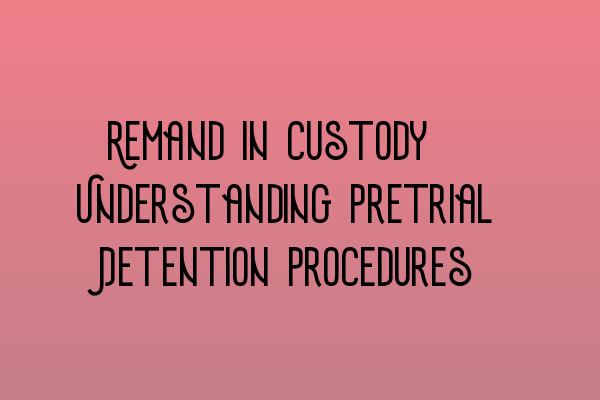Remand in Custody: Understanding Pretrial Detention Procedures
When it comes to criminal law in the UK, remand in custody is an important concept to understand. It refers to the practice of holding a person accused of a crime in custody before their trial. This can have significant implications for the individual, as well as their legal rights and the progress of the case.
In this article, we will delve into the details of remand in custody, its purpose, procedures, and the factors that influence the decision-making process. Whether you’re a legal professional, a student, or simply interested in the criminal justice system, this article will provide valuable insights into this essential aspect of criminal law.
What is Pretrial Detention?
Pretrial detention, also known as remand in custody, occurs when a person is held in custody awaiting their trial. It is an integral part of the criminal justice system and serves multiple purposes, including:
- Ensuring the accused appears at trial
- Preventing the accused from committing further offenses
- Protecting the safety of the public
- Preserving evidence
- Maintaining confidence in the criminal justice system
Now, let’s explore the procedures involved in remand in custody:
Procedures for Remand in Custody:
In the UK, the decision to remand an accused person in custody is not taken lightly. There are strict procedures in place to ensure fairness and safeguard the individual’s rights.
1. Initial Custody Hearing: After an arrest, the accused is brought before a court for an initial custody hearing. In this hearing, the court considers factors such as the seriousness of the offense, the accused’s criminal record, and the likelihood of reoffending.
2. Bail Determination: Following the initial custody hearing, the court determines whether the accused is eligible for bail. Bail may be granted if the court believes the accused will attend their trial and does not pose a risk to the public.
3. Bail Conditions: If bail is granted, the court may impose certain conditions on the accused, such as reporting to a police station regularly or surrendering their passport. These conditions aim to manage any potential risks associated with releasing the accused from custody.
4. Reconsideration of Bail: If bail is denied, the accused may request a reconsideration of their bail application. This typically involves presenting new evidence or arguments to support their release.
5. Pretrial Detention: If the court determines that remand in custody is necessary, the accused is held in detention until their trial. The length of detention can vary depending on the complexity of the case and the availability of court dates.
6. Review of Detention: The decision to detain an accused person is subject to periodic reviews. These reviews ensure that detention remains necessary and proportionate, taking into account any changes in circumstances.
It is essential to note that the decision to remand in custody is not final and can be challenged at any stage of the pretrial process.
Factors Influencing the Decision:
Several factors are considered when determining whether to remand an accused person in custody:
- The seriousness of the offense
- The risk of flight
- The risk of reoffending
- The strength of the evidence against the accused
- The potential danger the accused poses to the public
- The accused’s ties to the community
- Previous criminal record
All of these factors play a role in the decision-making process and are carefully analyzed by the court.
